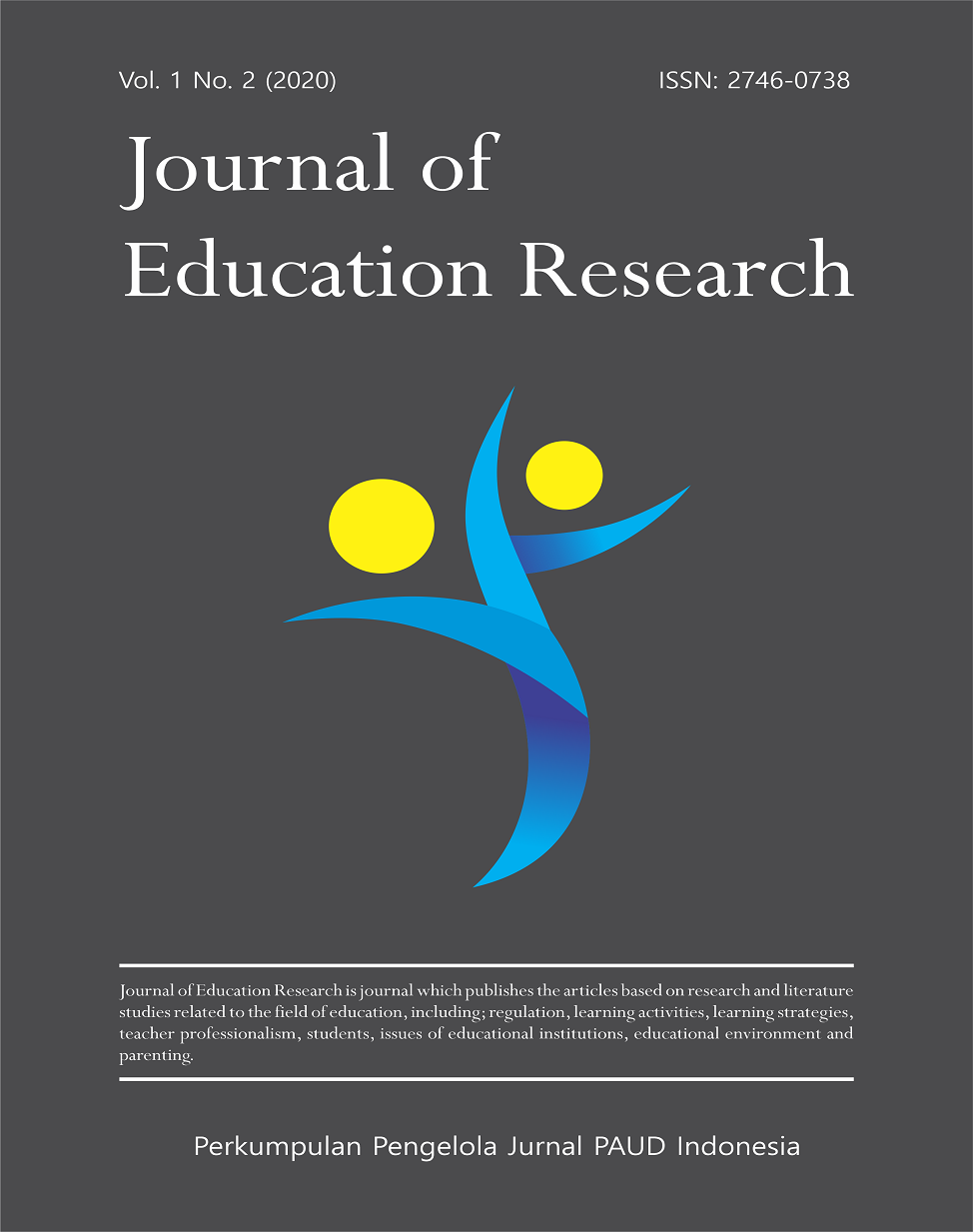Pencegahan Bullying dalam Pendidikan Anak Usia Dini
DOI:
https://doi.org/10.37985/jer.v2i3.55Keywords:
Anak Usia Dini, Bullying, Bullying Anak Usia Dini, Pencegahan Bullying, Pendidikan Anak Usia DiniAbstract
Bullying merupakan masalah yang serius bagi anak-anak, karena bullying dapat memberikan efek negatif bagi anak yang menjadi korban bullying seperti rendahnya harga diri, kecemasan yang berlebihan dan depresi. Pada usia dini menjadi salah satu periode yang mendasar dalam mencegah dan menghentikan bullying. Banyak penelitian terbaru menunjukkan bahwa bullying terjadi pada anak usia dini. Jenis-jenis bullying pada anak usia dini adalah fisik, verbal dan relasional. Sebagai guru dalam pendidikan anak usia dini hendaknya memberikan lingkungan yang aman dan nyaman pada anak dalam mencegah bullying saat ini. Tujuan dari peninjauan ini adalah untuk menyajikan bukti empiris tentang bullying pada anak usia dini, karakteristik anak yang terlibat dalam bullying, impilikasi guru dalam mencegah bullying, dan program pencegahan bullying pada anak usia dini.
Downloads
References
Hinitz, B., Shore, M., & Kumara, A. (2010). Making Anti-Bullying Research a Part of Early Childohood Classroom Practice in Comparative International Contexts: The United States and Indonesia. AFRA.
Storey, K., & Slaby, R. (2013). Eyes on Bullying in Early Childhood. USA: Education Development Center.
Olweus, D. (1997). Bully / Victim Problems in School: Facts and Intervention. European Journal of Psychology of Education, XII (4), 495-510.
Kirves, L., & Sajaniemi, N. (2012). Bullying in Early Educational Settings. Early Child Development and Care, 182 (3-4), 383-400. http://dx.doi.org/10.1080/03004430.2011.646724
Repo, L. (2015). Bullying and Its Prevention in Early Childhood Education. Helsinki: University of Helsinki. ISBN 978-951-51-0200-3, ISSN 1799-2508.
Vlachou, M., Botsoglou, K., & Andreou, E. (2013). Assessing bully/victim Problems in preschool children: A multimethod approach. Journal of Criminology, 8 pages. Article ID 301658
Lee, S.-H., Smith, P. K., & Monks, C. (2011). Perception of bullying-like phenomena in South Korea: A qualitative approach from a lifespan perspective. Journal of Aggression, Conflict and Peace Research, 3, 210–221.
Monks, C., & Smith, P. K. (2010). Peer, self and teacher nominations of participant roles taken in victimization by five- and eight-years-old. Journal of Aggression, Conflict and Peace Research 2(4), 4–14
Alsaker, F., & Nägele, C. (2008). Bullying in kindergarten and prevention. In D. Pepler & W. Craig (Eds.), Understanding and addressing bullying: An international perspective, 230–252. Bloomington, IN: Bloomington.
Alsaker, F. D., & Valkanover, S. (2001). Early diagnosis and prevention of victimization in kindergarten. In J. Juvonen & S. Graham (Eds.), Peer harassment in school: The plight of the vulnerable and victimized. New York, NY: Guilford Press.
Perren, S., & Alsaker, F. (2006). Social behavior and peer relationships of victims, bully-victims, and bullies in kindergarten. Journal of Child Psychology and Psychiatry, 47, 45–57.
Alsaker, F., & Gutzwiller-Helfenfinger, E. (2010). Social behavior and peer relationships of victims, bully-victims and bullies in kindergarten. In S. R. Jimerson, S. M. Swearer, & D. L. Espelage (Eds.), Handbook of bullying in schools: An international perspective (pp. 87–100). New York, NY: Routledge.
Reunamo, J., Kalliomaa, M., Repo, L., Salminen, E., Lee., H-C., & Wang, L-C. (2014).ChildrenÂ’s Strategies in Addressing Bullying Situations in Day Care and Preschool. Early Child Development and Care 185 (6), 952-967. http://dx.doi.org/10.1080/03004430.2014.973871
Wahyudin, S.T. (2017). Statistika Ekonomi Konsep, Teori dan Penerapan. Malang: Ub Press.
Tanrikulu, I. (2018). Teacher reports on early childhood bullying: how often, who, what, when and where. Early Child Development and Care, 1–13. doi:10.1080/03004430.2018.1479404
Ambarini, R., Indrariani, E. A., & Zahraniani, A. D. (2018). Antisipasi Pencegahan Bullying Sedini Mungkin: Program Anti Bullying Terintegrasi untuk Anak Usia Dini. Journal of Dedictors Community UNISNU Jepara, 2 (2), p-ISSN 2548-8783
Splete, H. (2005, October). Preschool environment predicts grade school bullying. Pediatric News, 39 (10), 33. Retrieved from http://go.galegroup.com.ezproxy. stthomas.edu/ps/i.do?id=GALE%7CA138141213&v=2.1&u=clic_stthomas&it=r &p=ITOF&sw=w
Huston, J., & Bailey, S.J. (2008). Children and Bullying: A Guide For Parents. Monata State University
Gültekin-Akduman, G. (2012). Okul öncesi dönemde akran zorbaliğının incelenmesi. Journal of Society & Social Work, 23(1), 121–137
Jansen, P. W., Verlinden, M., Dommisse-van Berkel, A., Mieloo, C., van der Ende, J., Veenstra, R., … Tiemeier, H. (2012). Prevalence of bullying and victimization among children in early elementary school: Do family and school neighbourhood socioeconomic status matter? BMC Public Health, 12(1), 145.
Özdemir, S., & Tepeli, K. (2015). Okul öncesi çocuklarda görülen fiziksel ve ilişkisel saldırganlık davranışlarının incelenmesi. Uluslararası Avrasya Sosyal Bilimler Dergisi, 6(18), 229–245.
Bradshaw, C. P., & Johnson, R. M. (2011). The social context of bullying and peer victimization: An introduction to the special issue source. Journal of School Violence, 10(2), 107–114.
Downloads
Published
How to Cite
Issue
Section
License
Copyright (c) 2021 Despa Ayun

This work is licensed under a Creative Commons Attribution-ShareAlike 4.0 International License.
Authors who publish with this journal agree to the following terms:
- Authors retain copyright and grant the journal right of first publication with the work simultaneously licensed under a Creative Commons Attribution-ShareAlike 4.0 International License that allows others to share the work with an acknowledgement of the works authorship and initial publication in this journal.Â
- Authors are able to enter into separate, additional contractual arrangements for the non-exclusive distribution of the journals published version of the work (e.g., post it to an institutional repository or publish it in a book), with an acknowledgement of its initial publication in this journal.
- Authors are permitted and encouraged to post their work online (e.g., in institutional repositories or on their website) prior to and during the submission process, as it can lead to productive exchanges, as well as earlier and greater citation of published work (See The Effect of Open Access).









